
SKIING HISTORY
Editor Kathleen James
Art Director Edna Baker
Contributing Editor Greg Ditrinco
ISHA Website Editor Seth Masia
Editorial Board
Seth Masia, Chairman
John Allen, Andy Bigford, John Caldwell, Jeremy Davis, Kirby Gilbert, Paul Hooge, Jeff Leich, Bob Soden, Ingrid Wicken
Founding Editors
Morten Lund, Glenn Parkinson
To preserve skiing history and to increase awareness of the sport’s heritage
ISHA Founder
Mason Beekley, 1927–2001
ISHA Board of Directors
John Fry (1930-2020), Chairman
Seth Masia, President
Wini Jones, Vice President
Jeff Blumenfeld, Vice President
John McMurtry, Vice President
Chan Morgan, Treasurer
Einar Sunde, Secretary
Richard Allen, Skip Beitzel, Michael Calderone, Christin Cooper, Art Currier, Dick Cutler, Chris Diamond, David Ingemie, Joe Jay Jalbert, Rick Moulton, Wilbur Rice, Charles Sanders, Bob Soden (Canada)
Presidential Circle
Christin Cooper, Billy Kidd, Jean-Claude Killy, Bode Miller, Doug Pfeiffer, Penny Pitou, Nancy Greene Raine
Business & Events Manager
Kathe Dillmann
P.O. Box 1064
Manchester Center VT 05255
(802) 362-1667
kathe@skiinghistory.org
Membership Services
Laurie Glover
(802) 375-1105
laurie@skiinghistory.org
Corporate Sponsorships
Peter Kirkpatrick
(541) 944-3095
peterk10950@gmail.com
Bimonthly journal and official publication of the International Skiing History Association (ISHA)
Partners: U.S. Ski and Snowboard Hall of Fame | Canadian Ski Museum and Hall of Fame
Alf Engen Ski Museum | North American Snowsports Journalists Association | Swiss Academic Ski Club
Skiing History (USPS No. 16-201, ISSN: 23293659) is published bimonthly by the International Skiing History Association, P.O. Box 1064, Manchester Center, VT 05255.
Periodicals postage paid at Manchester Center, VT and at additional mailing offices. Postmaster: Send address changes to ISHA, P.O. Box 1064, Manchester Center, VT 05255
ISHA is a 501(c)(3) public charity. EIN: 06-1347398
Written permission from the editor is required to reproduce, in any manner, the contents of Skiing History, either in full or in part.
Paul Ryan: A Decisive Moment in Time, Part 2
Amateur photographers: Paul Ryan feels your pain.
Blue sky, green trees, white snow, happy skier. Every ski photographer risks producing cliché images.
Paul Ryan understands. “In today’s world, we are saturated with photographs in the media and online. Sometimes when I go out to shoot, these images pop up and scream at me ‘Someone’s done that! I’ve seen that!’” he says.
Ryan, 83, offers this wisdom gleaned from six decades behind a lens: “Be open for something odd and new, not necessarily strange, but a different vision of the familiar. Perhaps a juxtaposition of disparate elements in the same frame. Wash from your mind all the classic images that linger from the past. Images by others you’ve seen and loved, even images that you see right away—the obvious.”
To that end, when shooting, he strives for “an empty mind, or at least a clean vision,” a reference to the 1970 book Zen Mind, Beginner’s Mind, which he found inspiring early in his career.
Photo top of page: Ryan started his career as the staff photographer at California’s Sugar Bowl resort. The Silver Belt, the final big race of the season, was held in the late spring. Part of the post-race festivities was a softball game on skis between the racers. “The European racers, unfamiliar with baseball, found the game amusing,” Ryan says. Buddy Werner, a natural athlete and a born competitor, took the softball game—and winning it—seriously. Those are American Olympians Tom Corcoran and Linda Meyers watching the action.
Ryan grew up in Boston and, after taking a BS in engineering, moved to Stowe to pursue what he imagined could be a career in ski racing. An Eastern snow drought in 1960-61 led him to Aspen, and for a few years he spent winters racing and summers in San Francisco, going to film school. He eventually found himself at Sugar Bowl Resort in California for the final race of the season, where general manager Ed Siegel candidly told him that his future wasn’t in ski racing, and hired him as resort photographer.
It was a good fit. John Fry eventually hired Ryan as the staff photographer at SKI magazine for several years. He traveled the world shooting for SKI and other periodicals.
But his professional pursuits expanded beyond skiing. He chronicled the 1960s counterculture in San Francisco. He studied under the greats of the time, including Minor White and Ansel Adams. His photography has been honored in numerous shows, with recent exhibits including “The Sea Ranch, Architecture, Environment, and Idealism” at the San Francisco Museum of Modern Art.
Ryan has easily pivoted between photography and cinematography. His cinema credits include Robert Redford’s “A River Runs Through It” and “The Horse Whisperer.” His documentary work includes “Gimme Shelter,” “Salvador Dali,” and recently a film on George Soros.
He has always found his way back to the mountains. Here are some of his favorite images from a different era. “When on the side of the mountain, I had to pre-visualize the end result, not seeing the film until days later,” Ryan says from his home in Santa Monica, California.
Ryan said that White, one of his early mentors, introduced him to the idea that a compelling photograph is more than a static image—it has an afterlife, of sorts.
“White spoke of ‘Equivalents,’ which is a photographic concept that the photograph mirrors something in ourselves—something that remains in mind after the literal image has faded,” Ryan explains.
To reach that end, Ryan says, the strongest images touch upon a commonality, something universal across the human experience. These images draw the viewer into the frame and into a broader narrative. “The most powerful photos evoke something beyond what was literally in front of the lens. This may come from the implication of what happened just before or of what might happen a moment after,” he says. “What remains is not only the image of the time and place, but a visual residue connected to a broader spectrum of our own experience.”
Of course, in order to achieve White’s concept of “Equivalents,” the photographer does have to first nail the shot. These days, with everyone shooting an endless stream of digital photos at the press of a button, that’s an achievement that’s often underappreciated.
Not by Ryan. “To achieve a high level of visual acuity is demanding,” he notes, “particularly while simultaneously navigating deep powder, an icy mogul field, high speeds or the intensity of race day—all with an array of cameras in check.” 
This is the second installment of a two-part photo essay series from Paul Ryan. (See part 1 in the September/October issue.) View this photo essay as a mini-master class in photography, as Ryan explains his approach to his craft and the intriguing backstories to each image. Find more of Ryan’s work at paulryanphotography.com.
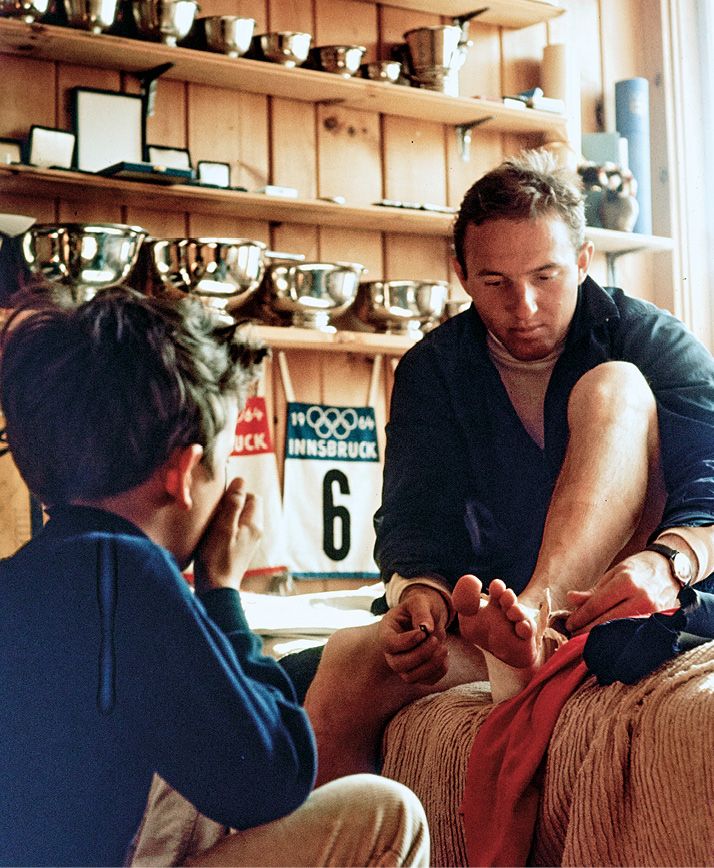 Ryan first got to know Billy Kidd during the 1960 season at Stowe. “He was always friendly and curious about photography and actually filmed some of the Megève downhill for me when I was making the Lange film, Ski Racer. This photo was taken at Kidd’s home in Stowe circa 1967. The wall was lined with trophies and his bibs from the 1964 Innsbruck Olympics, where Kidd and Jimmie Heuga became the first American men to win alpine medals. “Ever since 1966, Billy was plagued with recurring ankle injuries,” Ryan recalls. “It was interesting to see a young admirer realizing that even a hero is vulnerable.” Ryan was fascinated throughout his career with catching athletes away from the competition, believing that these moments can tell a story as revealing as the athletic action itself.
Ryan first got to know Billy Kidd during the 1960 season at Stowe. “He was always friendly and curious about photography and actually filmed some of the Megève downhill for me when I was making the Lange film, Ski Racer. This photo was taken at Kidd’s home in Stowe circa 1967. The wall was lined with trophies and his bibs from the 1964 Innsbruck Olympics, where Kidd and Jimmie Heuga became the first American men to win alpine medals. “Ever since 1966, Billy was plagued with recurring ankle injuries,” Ryan recalls. “It was interesting to see a young admirer realizing that even a hero is vulnerable.” Ryan was fascinated throughout his career with catching athletes away from the competition, believing that these moments can tell a story as revealing as the athletic action itself.
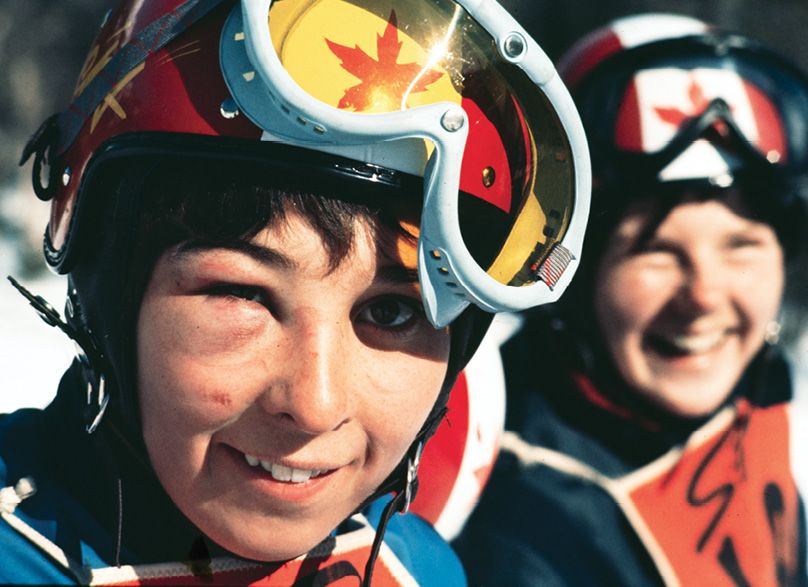 One of the many challenges of nailing a great image is “photographing people up close in difficult situations,” Ryan says. Fortunately, Ryan had spent a lot of time with the Canadian team and earned its trust, such as after a nasty downhill tumble by racer Andrée Crepeau, who recalls the crash. “It was on the flats at the bottom of the downhill in Stowe, where I learned that catching an edge is not always reversible. And down I went, face first—real quick.” The resulting image captures both the physical toll of the crash and the indominable spirit of the Canadian’s women’s team. “In photographing emotional situations, it’s always better to be physically close to the people rather than standing farther back with a telephoto lens,” Ryan says.
One of the many challenges of nailing a great image is “photographing people up close in difficult situations,” Ryan says. Fortunately, Ryan had spent a lot of time with the Canadian team and earned its trust, such as after a nasty downhill tumble by racer Andrée Crepeau, who recalls the crash. “It was on the flats at the bottom of the downhill in Stowe, where I learned that catching an edge is not always reversible. And down I went, face first—real quick.” The resulting image captures both the physical toll of the crash and the indominable spirit of the Canadian’s women’s team. “In photographing emotional situations, it’s always better to be physically close to the people rather than standing farther back with a telephoto lens,” Ryan says.
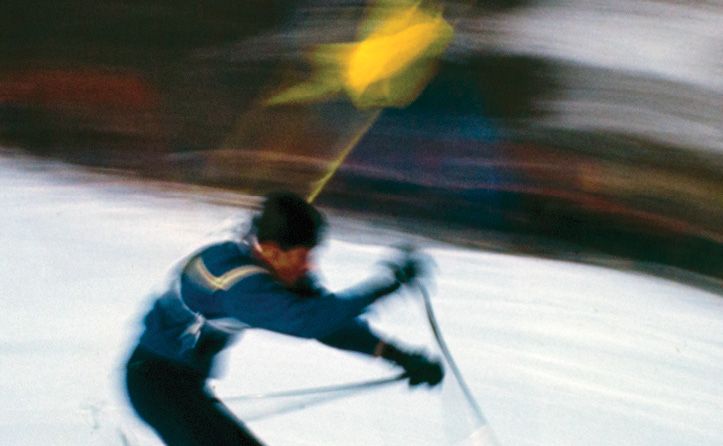 Great photography is at the intersection of art and science, according to Ryan. Getting the technical aspects right, such as the light, focus and framing, is key. But some of it is just heading into the field and hoping for the best. “Shooting ski action at slower than normal shutter speeds, here 1/8 second, is photographing without the luxury of certainty,” Ryan says. “After a while you get better at anticipating the results, but it’s still guesswork.” Here, at Stowe, the “obscuration of the subject promotes an awareness of the overall graphics in the frame.” Ryan also liked the flame-like gate banner flickering above the racer’s head.
Great photography is at the intersection of art and science, according to Ryan. Getting the technical aspects right, such as the light, focus and framing, is key. But some of it is just heading into the field and hoping for the best. “Shooting ski action at slower than normal shutter speeds, here 1/8 second, is photographing without the luxury of certainty,” Ryan says. “After a while you get better at anticipating the results, but it’s still guesswork.” Here, at Stowe, the “obscuration of the subject promotes an awareness of the overall graphics in the frame.” Ryan also liked the flame-like gate banner flickering above the racer’s head.
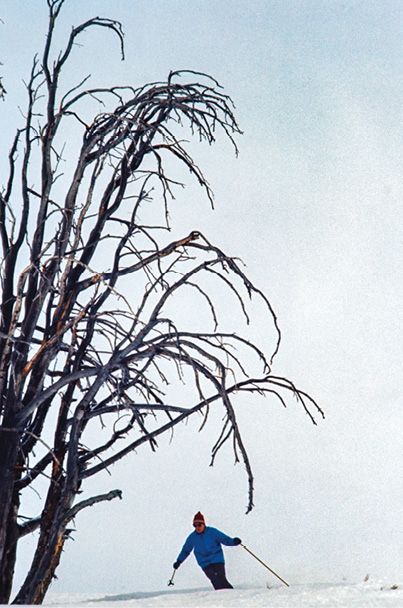 Contrasts help bring a viewer into the frame, seeking out details of the surprising image. “In this case it was the ominous dark tree in the white landscape that attracted me,” Ryan says. “I waited for a bit, assuming a skier would come into the frame. He did and that completed the image.”
Contrasts help bring a viewer into the frame, seeking out details of the surprising image. “In this case it was the ominous dark tree in the white landscape that attracted me,” Ryan says. “I waited for a bit, assuming a skier would come into the frame. He did and that completed the image.”



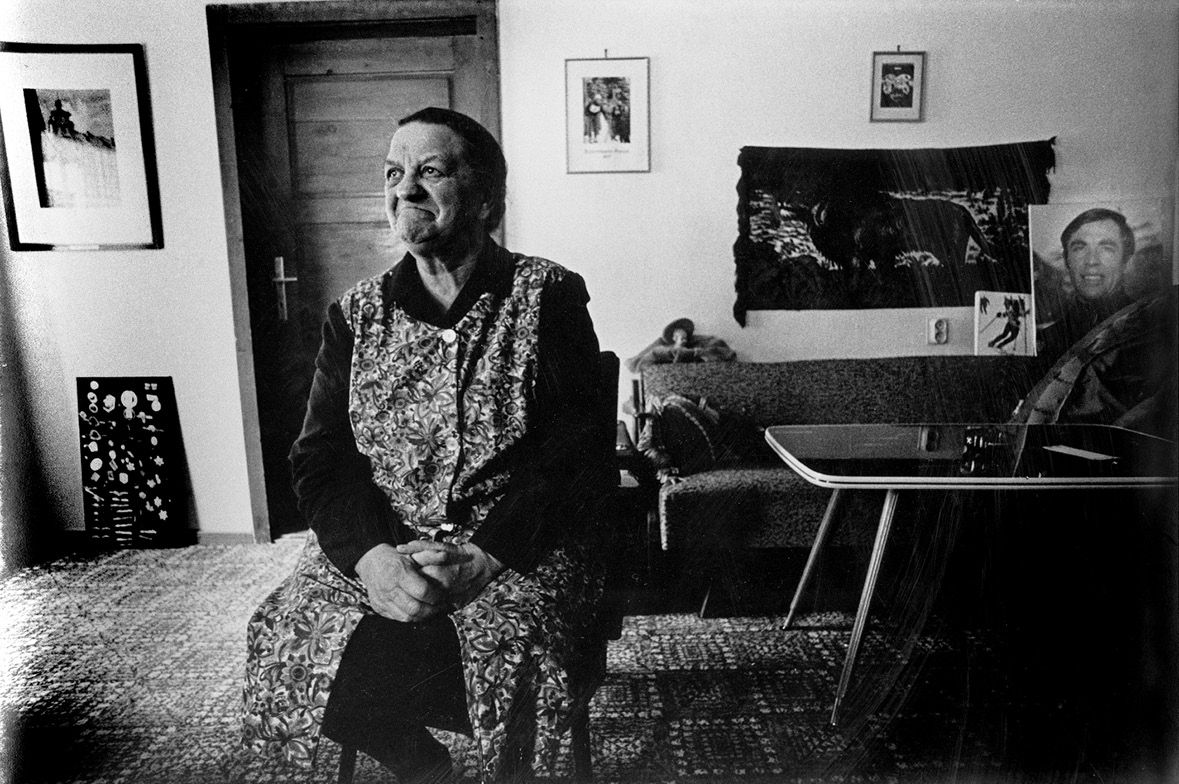 In 1970, Ryan made a documentary film on Austrian ski champion Karl Schranz. He filmed for several weeks on the World Cup circuit. “But I was curious to film Karl’s off-season life in his hometown of St. Anton,” Ryan says. He traveled to St. Anton in the summer, after the race season, and talked to locals who knew Schranz since his boyhood. “Karl brought us to meet his mother, who lived in the same small house she had for the last fifty years,” Ryan recalls. “As a widow, she had raised five children.” With photos and medals decorating this modest shrine to her son, Ryan likes the image because it tells as much about Schranz and his upbringing as it does about his mother.
In 1970, Ryan made a documentary film on Austrian ski champion Karl Schranz. He filmed for several weeks on the World Cup circuit. “But I was curious to film Karl’s off-season life in his hometown of St. Anton,” Ryan says. He traveled to St. Anton in the summer, after the race season, and talked to locals who knew Schranz since his boyhood. “Karl brought us to meet his mother, who lived in the same small house she had for the last fifty years,” Ryan recalls. “As a widow, she had raised five children.” With photos and medals decorating this modest shrine to her son, Ryan likes the image because it tells as much about Schranz and his upbringing as it does about his mother.
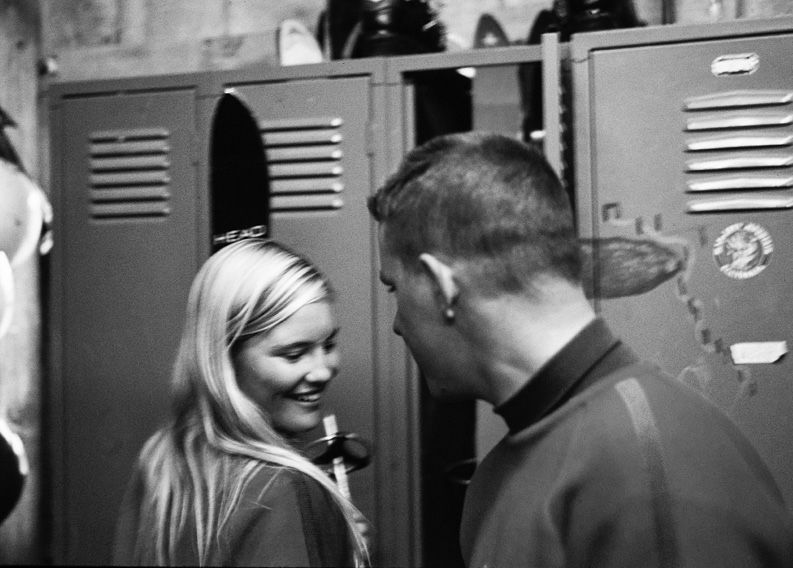 Mammoth was one of the first destinations on Ryan’s unofficial resort itinerary when he headed West as a young racer in the 1960s. “I spent a lot of time there, both skiing and photographing the Mammoth racing program.” The racing operation was a top-notch group, whose roster frequently included members of Mammoth founder Dave McCoy’s family. At the end of a training day, racer Kandi McCoy chats with Dennis Agee, a junior coach at the time, who went on to become the Alpine Director of the U.S. Ski Team. “I liked her shy reaction to a coach’s compliment,” Ryan says.
Mammoth was one of the first destinations on Ryan’s unofficial resort itinerary when he headed West as a young racer in the 1960s. “I spent a lot of time there, both skiing and photographing the Mammoth racing program.” The racing operation was a top-notch group, whose roster frequently included members of Mammoth founder Dave McCoy’s family. At the end of a training day, racer Kandi McCoy chats with Dennis Agee, a junior coach at the time, who went on to become the Alpine Director of the U.S. Ski Team. “I liked her shy reaction to a coach’s compliment,” Ryan says.
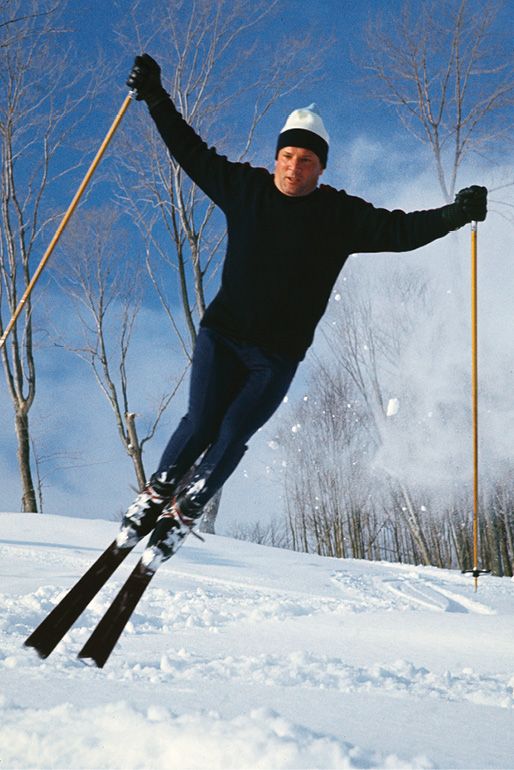 In 1968, John Fry “had the idea to send me to do a photo story on skiing in the flatlands of the Midwest” for SKI. Ryan ended up at Boyne Mountain, Michigan, with its modest vertical of 500 feet. “For Othmar Schneider, a past Olympic champion and previously at Stowe where I knew him, it must have been confining,” Ryan says. “This image had a feeling of him reaching for something greater—or at least higher.”
In 1968, John Fry “had the idea to send me to do a photo story on skiing in the flatlands of the Midwest” for SKI. Ryan ended up at Boyne Mountain, Michigan, with its modest vertical of 500 feet. “For Othmar Schneider, a past Olympic champion and previously at Stowe where I knew him, it must have been confining,” Ryan says. “This image had a feeling of him reaching for something greater—or at least higher.”
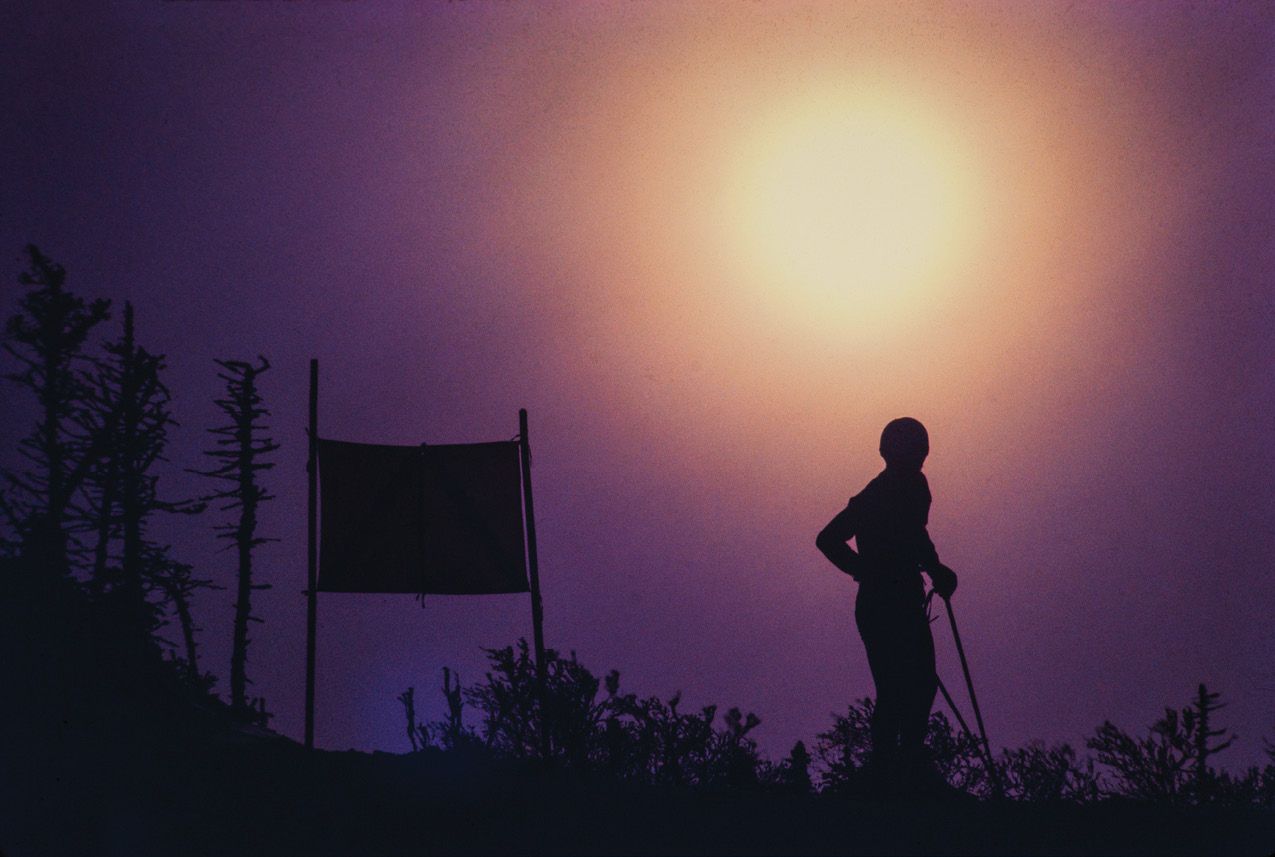 John Fry and Mort Lund assigned Ryan to do a photo essay for SKI specifically on the experience of the downhill discipline. “This is the only event where there is a day or more to prepare, inspecting the course and taking a practice run,” Ryan says. “But there is never the sense of totally understanding what it will be like on race day.” At the end of the day prior to the race, there’s one last inspection down the course. Ryan strived to capture the intense preparation and anticipation in this early evening shot of a solitary racer looking down the course. Ryan: “I often find it rewarding to hang around for that extra hour at the end of the day, after the main action has ended. The light is dramatic and interesting things sometimes happen.”
John Fry and Mort Lund assigned Ryan to do a photo essay for SKI specifically on the experience of the downhill discipline. “This is the only event where there is a day or more to prepare, inspecting the course and taking a practice run,” Ryan says. “But there is never the sense of totally understanding what it will be like on race day.” At the end of the day prior to the race, there’s one last inspection down the course. Ryan strived to capture the intense preparation and anticipation in this early evening shot of a solitary racer looking down the course. Ryan: “I often find it rewarding to hang around for that extra hour at the end of the day, after the main action has ended. The light is dramatic and interesting things sometimes happen.”
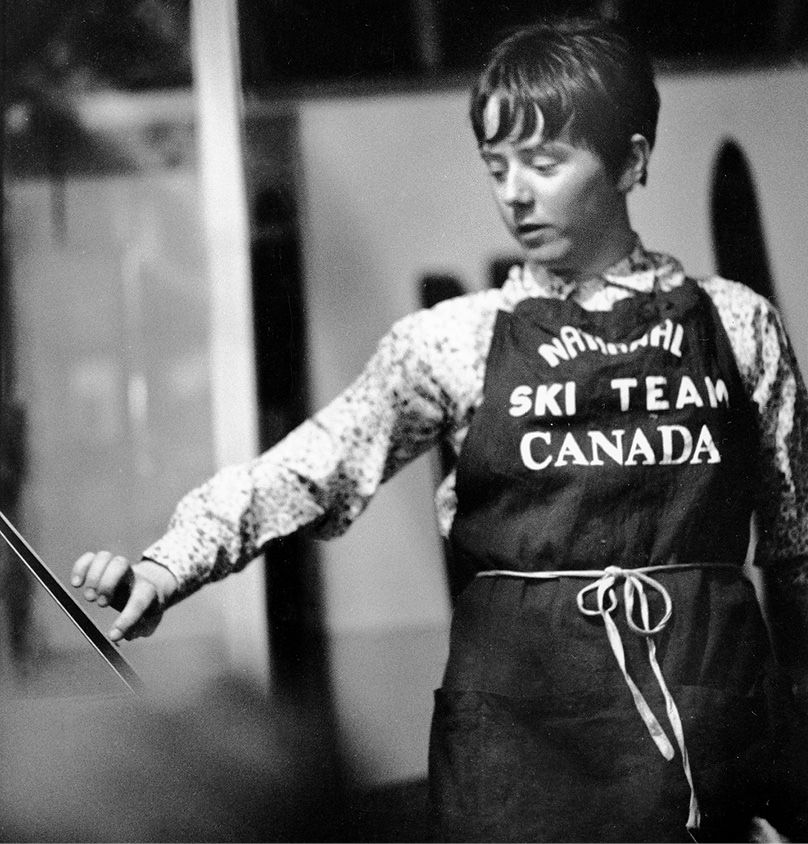 All photographers have favorite assignments. This was one of Ryan’s. “One of my first and most gratifying assignments at SKI was a photo essay on Nancy Greene on the 1967 race circuit. I followed her travels for three weeks, on and off the course,” Ryan says. As well as being a superb racing talent, Ryan learned that Greene was a good friend and dedicated mentor to her teammates. Greene also didn’t let any aspect of her gear go uninspected. “Like many racers of the era, she personally paid exacting attention to the details of her skis,” Ryan says.
All photographers have favorite assignments. This was one of Ryan’s. “One of my first and most gratifying assignments at SKI was a photo essay on Nancy Greene on the 1967 race circuit. I followed her travels for three weeks, on and off the course,” Ryan says. As well as being a superb racing talent, Ryan learned that Greene was a good friend and dedicated mentor to her teammates. Greene also didn’t let any aspect of her gear go uninspected. “Like many racers of the era, she personally paid exacting attention to the details of her skis,” Ryan says.
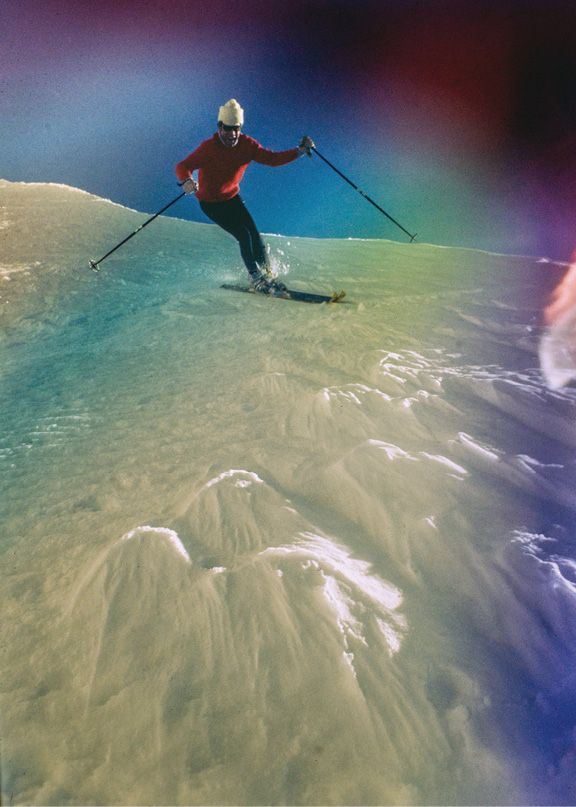 For Ryan’s 1969 photo essay, “The Steepness of Stowe” for SKI, he began experimenting with colored gel filters on the lens. “I liked the creative effect and usually made a few photographs this way on most other assignments,” Ryan notes, such as here as part of a story on Roger Staub at Vail (see right). With the analog film of the time, there was no way to know how the gels were working until the film was processed days later.
For Ryan’s 1969 photo essay, “The Steepness of Stowe” for SKI, he began experimenting with colored gel filters on the lens. “I liked the creative effect and usually made a few photographs this way on most other assignments,” Ryan notes, such as here as part of a story on Roger Staub at Vail (see right). With the analog film of the time, there was no way to know how the gels were working until the film was processed days later.
 Digital photography now provides instant feedback (see above). “In contrast, a couple of years ago at the World Cup finals at Aspen I was fascinated with the maze of blue lines left by the multiple course markings. Shooting digitally, I could see the image right away and later, in Photoshop, I was able to exaggerate my impression of the intensity of the blue dye,” Ryan says. “Photography now has evolved to allow for, and even expect, imagery beyond simple representation of reality.”
Digital photography now provides instant feedback (see above). “In contrast, a couple of years ago at the World Cup finals at Aspen I was fascinated with the maze of blue lines left by the multiple course markings. Shooting digitally, I could see the image right away and later, in Photoshop, I was able to exaggerate my impression of the intensity of the blue dye,” Ryan says. “Photography now has evolved to allow for, and even expect, imagery beyond simple representation of reality.”
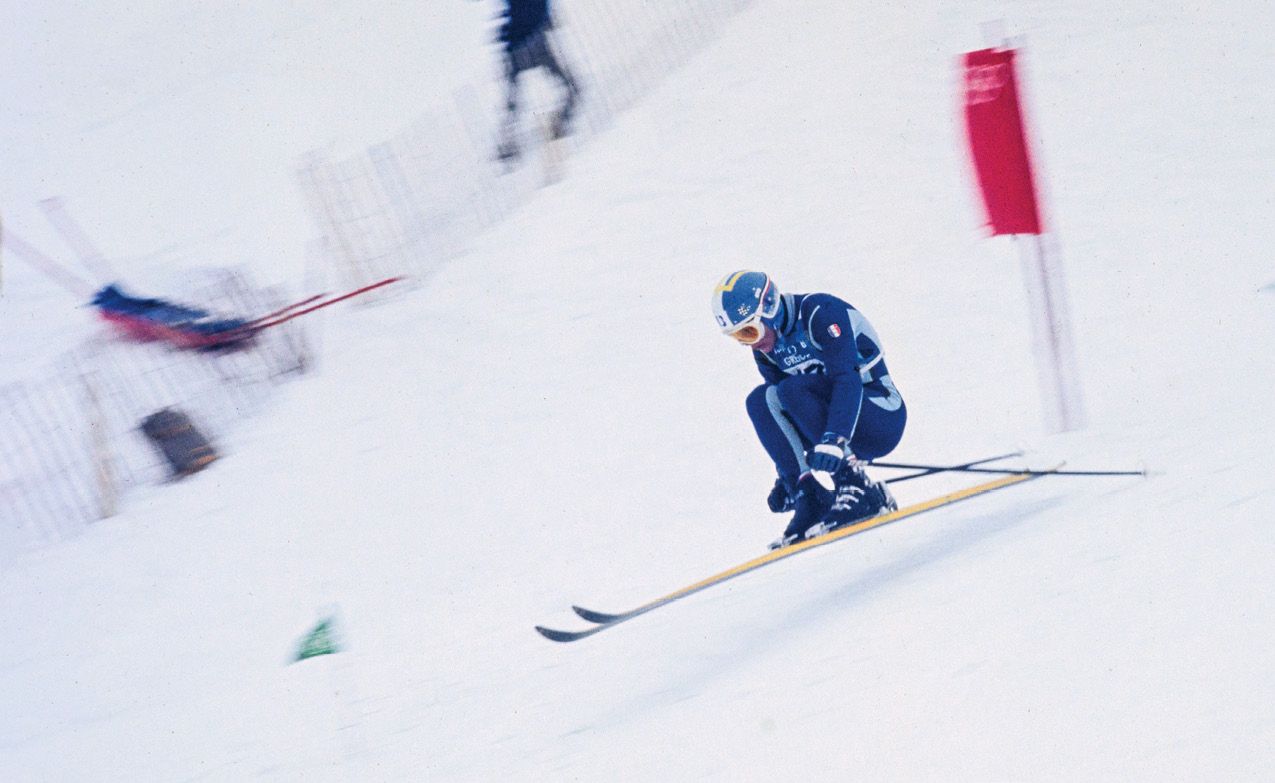 Beat writers are often accused of writing stories for the audience of other beat writers, bringing nuances into play that can only be picked up on by other pros. The same goes for photographers. Ryan was attracted to the action in this shot for a SKI assignment. The racer is in sharp focus at the 1968 Grenoble Winter Games, with other elements blurred. However, “I liked the patrol sled waiting in the background behind the fencing,” Ryan says. “It quietly portrayed a sense of risk and danger.”
Beat writers are often accused of writing stories for the audience of other beat writers, bringing nuances into play that can only be picked up on by other pros. The same goes for photographers. Ryan was attracted to the action in this shot for a SKI assignment. The racer is in sharp focus at the 1968 Grenoble Winter Games, with other elements blurred. However, “I liked the patrol sled waiting in the background behind the fencing,” Ryan says. “It quietly portrayed a sense of risk and danger.”
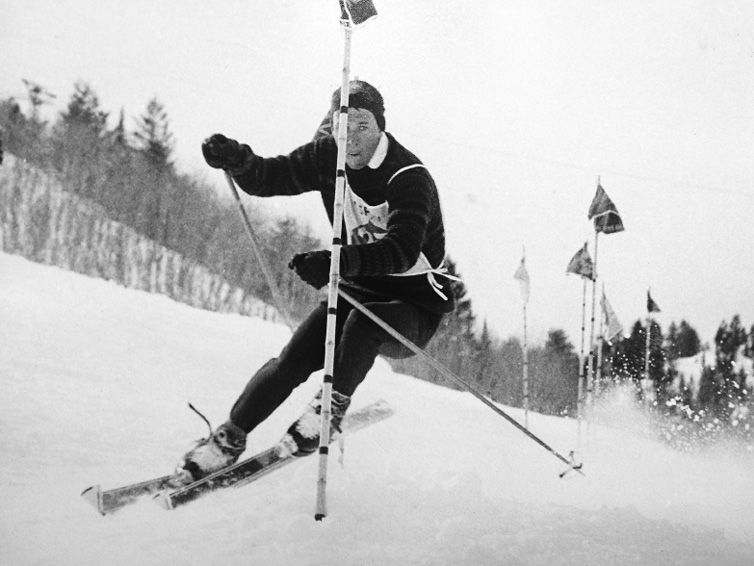 Ryan competed in the Roch Cup slalom in 1962, which became a hinge point in his career. “This was the last of my efforts at ski racing,” Ryan says. “I was decent, but when I was up against world-class racers, I realized I should spend more time at photography.” And for that decision in 1962, skiing’s visual legacy is, indeed, a bit richer.
Ryan competed in the Roch Cup slalom in 1962, which became a hinge point in his career. “This was the last of my efforts at ski racing,” Ryan says. “I was decent, but when I was up against world-class racers, I realized I should spend more time at photography.” And for that decision in 1962, skiing’s visual legacy is, indeed, a bit richer.

Table of Contents

Corporate Sponsors
ISHA deeply appreciates your generous support!
WORLD CHAMPIONSHIP ($3,000 AND UP)
Gorsuch
Polartec
WORLD CUP ($1,000)
Aspen Skiing Company
BEWI Productions
Bogner
Boyne Resorts
Dale of Norway
Darn Tough Vermont
Dynastar | Lange | Look
Fairbank Group: Bromley, Cranmore, Jiminy Peak
Gordini USA Inc. | Kombi LTD
HEAD Wintersports
Hickory & Tweed Ski Shop
Intuition Sports, Inc.
Mammoth Mountain
Marker-Volkl USA
National Ski Areas Association (NSAA)
Outdoor Retailer
Rossignol
Ski Area Management
Ski Country Sports
Snowsports Merchandising Corporation
Sport Obermeyer
Sports Specialists, Ltd.
Sun Valley Resort
Vintage Ski World
Warren and Laurie Miller
World Cup Supply, Inc.
GOLD ($700)
Race Place | BEAST Tuning Tools
The Ski Company (Rochester, NY)
Thule
SILVER ($500)
Alta Ski Area
Boden Architecture PLLC
Dalbello Sports
Ecosign Mountain Resort Planners
Fera International
Holiday Valley
Hotronic USA, Inc. | Wintersteiger
MasterFit Enterprises
McWhorter Driscoll, LLC
Metropolitan New York Ski Council
New Jersey Ski & Snowboard Council
NILS, Inc.
Russell Mace Vacation Homes
Schoeller Textile USA
Scott Sports
Seirus Innovations
SeniorsSkiing.com
Ski Utah
Swiss Academic Ski Club
Tecnica Group USA
Trapp Family Lodge
Western Winter Sports Reps Association
World Pro Ski Tour


